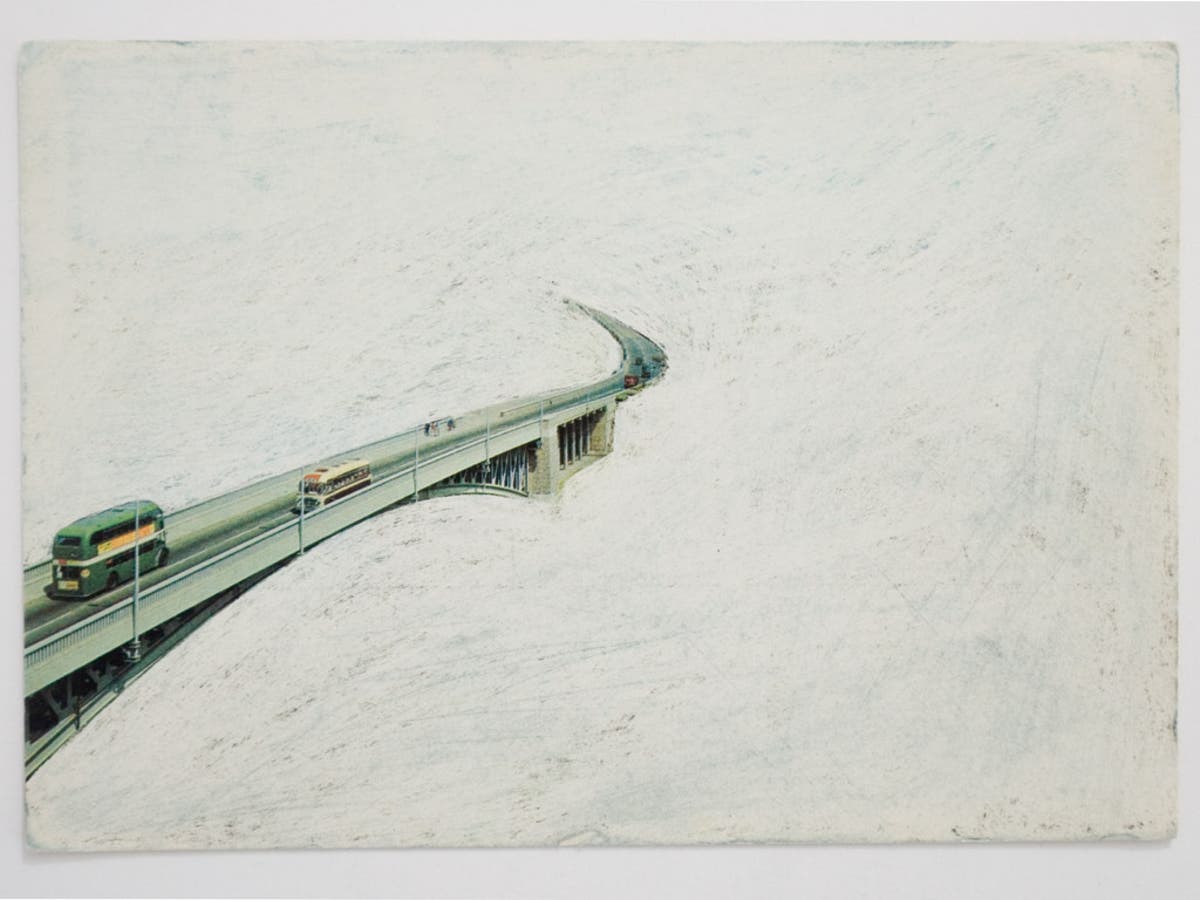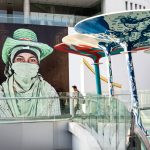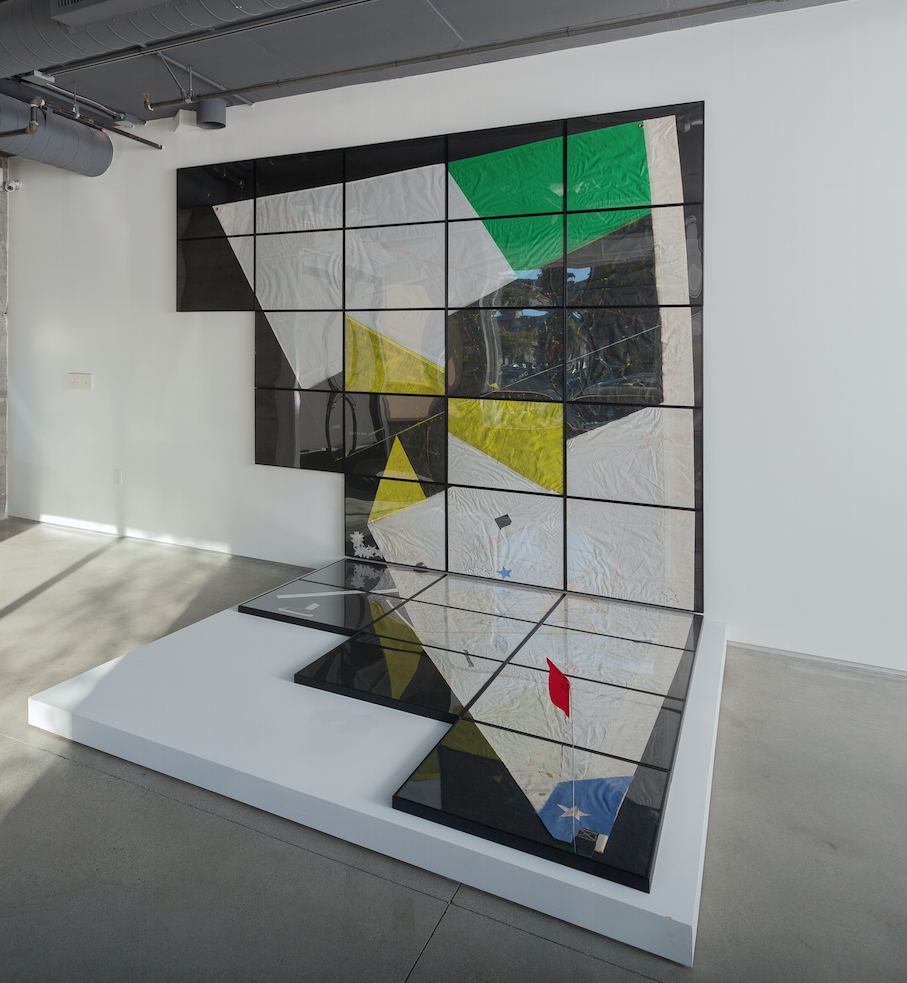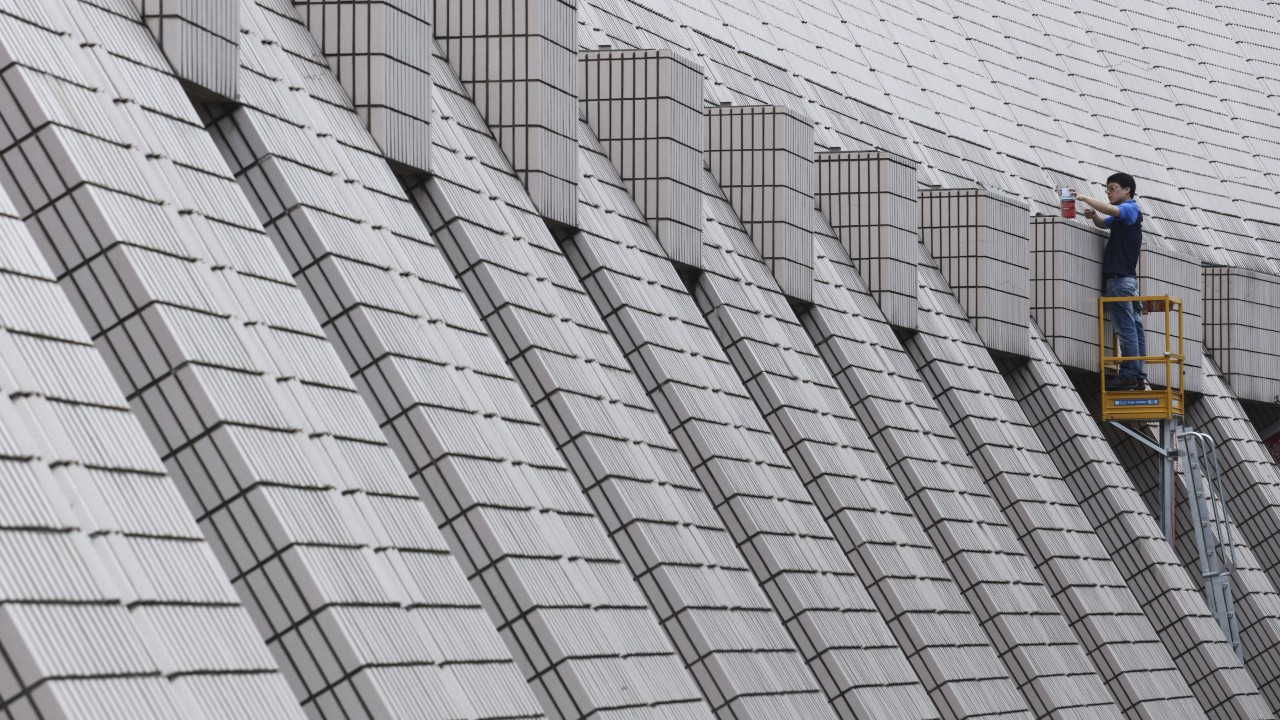n°5 The International Sail
2017 - Installation (Installation)
459H x 305W x 3D cm (180 x 120 x 1.2 inches)
Enrique Ramirez
Ramirez’s The International Sail is the fifth in a series that features an upside-down worn out, mended and fragmented boat sail. These works epitomize the idea of perpetual movement and migration while carrying a deep personal meaning in the creative process, as the artist’s father himself, still living in Chile, mends and sends the sails to his son, living in Europe. The reversed position of the sail recalls both the shape of South America itself and the Eurocentric view that in the Southern Hemisphere, everything is “upside-down.” The stitches themselves create an illusion of an alternative political geography, and the framed-cuts impose a cartographic grid.
Enrique Ramirez’s highly politicized practice engages both personal recollections and gathered stories, questions notions of exile, displacement, loss of memory, and a changing sense of place. Growing up in Santiago, Chile, his father was a sail-maker and Ramirez’s process often returns to the sea to bolster his investigations of movement, discovery, and geo-politics. The artist describes art and filmmaking as methods to communicate the ways society moves in cycles, sometimes backward and sometimes forward, especially regarding issues of immigration, border politics, and national identity. His seductive films and installations are sites of contemplation and imagination in their depiction of boundless space and expansive landscapes.
Colors:
Related works featuring themes of: » Black-and-White Photography, » Collective History, » Color Photography, » Conflict, » Chilean
» see more

© » KADIST
Shilpa Gupta
2014These hand drawn maps are part of an ongoing series begun in 2008 in which Gupta asks ordinary people to sketch outlines of their home countries by memory...

© » KADIST
Shilpa Gupta
2008The three monkeys in Don’t See, Don’t Hear, Don’t Speak are a recurring motif in Gupta’s work and refer to the Japanese pictorial maxim of the “three wise monkeys” in which Mizaru covers his eyes to “see no evil,” Kikazaru covers his ears to “hear no evil,” and Iwazaru covers his mouth to “speak no evil.” For the various performative and photographic works that continue this investigation and critique of the political environment, Gupta stages children and adults holding their own or each other’s eyes, mouths and ears...

© » KADIST
Bani Abidi
2008The threshold in contemporary Pakistan between the security of private life and the increasingly violent and unpredictable public sphere is represented in Abidi’s 2009 series Karachi ...

© » KADIST
Daniel Joseph Martinez
2005Martinez’s sculpture A meditation on the possibility… of romantic love or where you goin’ with that gun in your hand , Bobby Seale and Huey Newton discuss the relationship between expressionism and social reality in Hitler’s painting depicts the legendary Black Panther leaders Huey P...
Other related works, blended automatically
» see more

© » KADIST
Enrique Ramirez
2019Enrique Ramirez’s La Memoria Verde is a work of poetry, politics, and memory created in response to the curatorial statement for the 13th Havana Biennial in 2019, The Construction of the Possible ...

© » KADIST
Shilpa Gupta
2014These hand drawn maps are part of an ongoing series begun in 2008 in which Gupta asks ordinary people to sketch outlines of their home countries by memory...

© » KADIST
Shilpa Gupta
2008The three monkeys in Don’t See, Don’t Hear, Don’t Speak are a recurring motif in Gupta’s work and refer to the Japanese pictorial maxim of the “three wise monkeys” in which Mizaru covers his eyes to “see no evil,” Kikazaru covers his ears to “hear no evil,” and Iwazaru covers his mouth to “speak no evil.” For the various performative and photographic works that continue this investigation and critique of the political environment, Gupta stages children and adults holding their own or each other’s eyes, mouths and ears...

© » KADIST
Glenn Ligon
2000Glenn Ligon’s diptych, Condition Repor t is comprised of two side-by-side prints...
Related works sharing similar palette
» see more

© » THE INDEPENDENT
Artists' Postcards: A Compendium, By Jeremy Cooper | The Independent | The Independent Of interest to students of art and deltiologists (collectors of postcards) alike, Jeremy Cooper's extensively illustrated book provides the first critical study of the place of the humble postcard in the history of art...

© » ARTS EQUATOR
Weekly Southeast Asia Radar: Vietnam's post-war writers; Burmese voices in book | ArtsEquator Thinking and Talking about Arts and Culture in Southeast Asia ArtsEquator Radar BACC October 8, 2020 ArtsEquator’s Southeast Asia Radar features articles and posts about arts and culture in Southeast Asia, drawn from local and regional websites and publications – aggregated content from outside sources, so we are exposed to a multitude of voices in the region...

© » ARTEFUSE
Art Basel reveals 287 leading galleries and expanded city-wide program for its 2024 edition in Basel, Switzerland (News) - ArteFuse Art Basel reveals 287 leading galleries and expanded city-wide program for its 2024 edition in Basel, the first led by the show’s new Director Maike Cruse With 287 premier galleries from 40 countries and territories, Art Basel will once again bring together the international art world at its marquee fair in Basel, Switzerland...
Other works by: » Enrique Ramirez
» see more

© » KADIST
Enrique Ramirez
2019Enrique Ramirez’s La Memoria Verde is a work of poetry, politics, and memory created in response to the curatorial statement for the 13th Havana Biennial in 2019, The Construction of the Possible ...

© » KADIST
Enrique Ramirez
In Un Hombre que Camina (A Man Walking) (2011-2014), the sense of rhythm and timing is overpowered by the colossal sense of timelessness of this peculiar place...
Related works found in the same semantic group
» see more

© » KADIST
Charles Lim
2014In SEA STATE 6 Charles Lim takes the viewer down the Jurong Rock Caverns in Singapore, a massive underground infrastructure for oil and fuel storage, built to support the commercial operations of oil traders, petrochemical ventures and manufacturing industries in the area...

© » KADIST
Charles Lim
2014In SEA STATE 6 Charles Lim takes the viewer down the Jurong Rock Caverns in Singapore, a massive underground infrastructure for oil and fuel storage, built to support the commercial operations of oil traders, petrochemical ventures and manufacturing industries in the area...

© » KADIST
Laura Henno
2016In 2009, Laura Henno began research in the archipelago Comoros for her first film Koropa the first episode of a triptych— completed in 2016...


